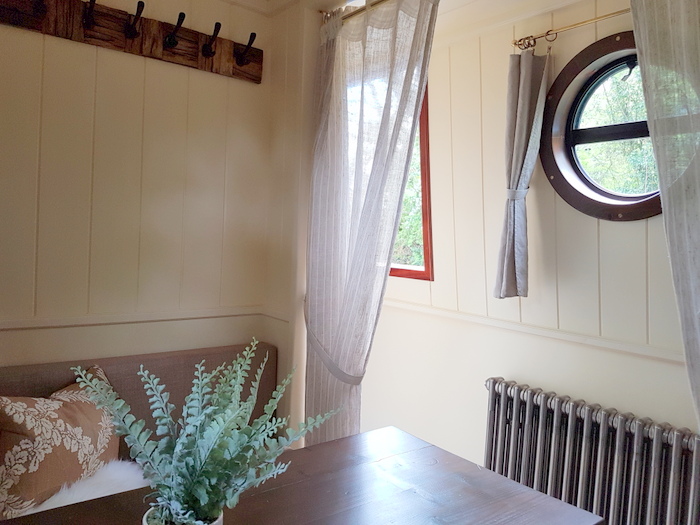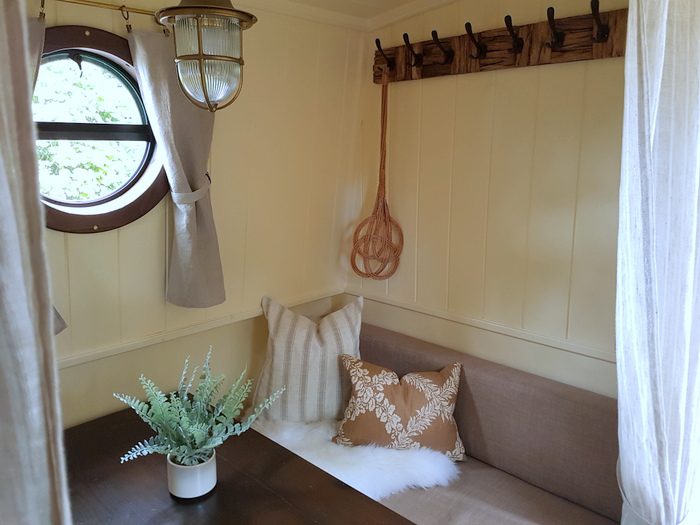Many boat owners and builders consider narrowboat dinettes to be essential part of the interior design. Most hire boats have one (or two) in order to maximise the number of berths. Before, say, 2020, boatbuilders also automatically installed dinettes into their fit outs for private customers.
But over the last two or three years, I’ve noticed a change. Certainly we have not built dinettes into our own holiday narrowboats in order to boost the contemporary appearance of the interiors. Even in our boatbuilding business, we’ve seen an increase in the number of clients wanting alternative seating and dining areas. Before we look at the options, let’s explore what makes the dinette so popular.
Narrowboat dinettes
A narrowboat dinette is a way of using the same footprint for dining, working, leisure time and sleeping.
The “face-to-face” style is the most often employed. However as you can see drawings below, an L-shaped dinette does create a more open space at eye level. There is a little wasted space in the corner of the L, but this design does create more generous and versatile seating. The lower drawing illustrates how your line of sight can be “blocked” by the back of the dinette, which is not visually appealling.

In addition to being an efficient use of floorspace if you need an extra bed, dinettes can also house additional storage beneath. Some boatbuilders create space for a freezer, for example. In one of our recent boat builds, we even managed to install an air-conditioning unit underneath.
Another benefit of the narrowboat dinette is that it can be created on a platform which brings eyelevel up and allows seated occupants to look out of the windows. This certainly makes a pleasant environment if you plan to work from the boat.

Drawbacks of narrowboat dinettes
If the bed part of the dinette is to be used regularly, drawbacks become obvious quite quickly. Over time, the legs of the table can become difficult to separate from the table-top and the foam cushions can become misshapen or uncomfortable. The storage under the dinette has to be used permanently for the duvet and bedding, which removes its overall value. And perhaps most obvious of all is the “faff” factor of literally clearing the table and building your bed every night. This kind of seating really is better suited to occasional use.
The other issue with dinettes is their general utilitarian appearance. They are expensive to build in comparison with many other interior design features on narrowboats. The wood is expensive, labour is expensive (because generally one size does not fit all.) And the bespoke upholstery is also an expensive element. And yet, despite the investment, the dinette often looks boring at best, and at worst, cheap. If you are spending all that money (and we are talking thousands of pounds here), then why not build something that looks truly individual?
Dinettes that work well
Not all dinettes are bad. One of my favourite features of one of our former hire boats was the face-to-face dinette (pictured below) inspired by the railway carriages of old. The seat backs extended up to the ceiling, becoming interior bulkheads. A curtain rail ran across the ceiling down the length of the boat and held two linen floor-to-ceiling curtains which cocooned the whole area. The table was solid wood – too heavy for regular conversion to a bed but perfect for the occasional guest. The upholstery unpretentious and actually quite simple in shape, which would keep costs down in the even of needing to replace.


The person who completed the fit out considered the dinette at the design stage. It wasn’t an after thought, shoe-horned into place. It was an integral part of the narrowboat and the end result was very desirable.
Alternative arrangements
That being said, we do try to keep the living area open and spacious on our own narrowboat interior designs and so favour seating and table tops which do not create additional bulk. My current favourite option is for a breakfast bar, which has the advantage of height over a traditional dining table or work desk. With this option you can look out of the window or side hatch easily.

The seating can actually be very flexible, too, allowing for folding stools when guests come round. We have designed breakfast bars which take centre stage for party boats, and slimline ones for when space is tight. Moreover, the bar is an extension of the kitchen, providing welcome usable work space.


Of course this arrangement won’t convert for sleeping and so we often recommend a sofa bed as the narrowboat’s main seating. A sofa has a far more contemporary appearance than a dinette. It brings warmth and texture through the use of cushions and throws, and is generally more inviting as a space to relax. The range of styles is huge and you can read about our preferred sofa beds here.
Which is right for your boat?
The seating and table solutions discussed here are not suitable for all canal boats in all circumstances and there are lots of additional options. If space is really tight, I would recommend fold-out tray tables. With a bit more room, you could consider a gateleg table and fold away chairs. These have the added bonus of being useful on warm summer nights on the towpath. Dinettes are no longer an essential feature of narrowboat design and the alternatives may well help you create a more modern interior, as well as bring down the overall fit-out cost.
Our aim at Boutique Narrowboats is to create beautiful interiors that work for narrow spaces. These spaces must be practical for the extreme environmental conditions of narrowboats. We happily share our experience in this journal for narrowboat interiors.


